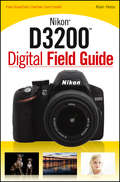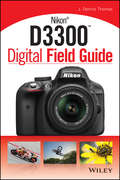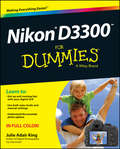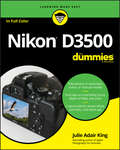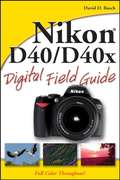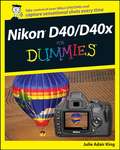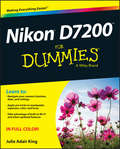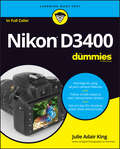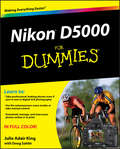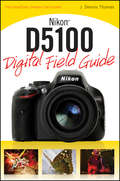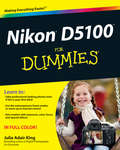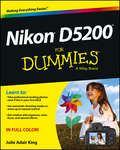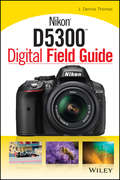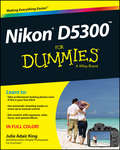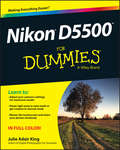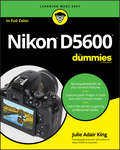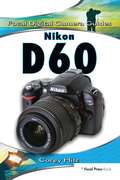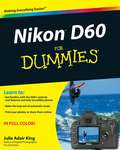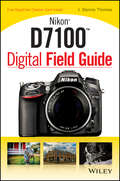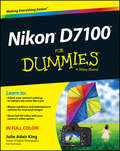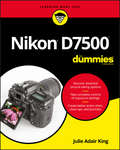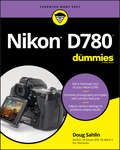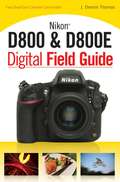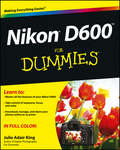- Table View
- List View
Nikon D3200 Digital Field Guide
by Alan HessA colorful, portable guide to all the features of Nikon's D3200 dSLRThe Nikon D3200 dSLR camera is packed with fabulous features like a 24-megapixel sensor, full HD video capability with fulltime autofocus, and 4 frames-per-second continuous shooting mode. This full-color guide provides instructions for all the buttons, dials, modes, and menus plus a refresher course in photography basics. It illustrates the essentials of lighting, composition, and exposure with plenty of examples, and author Alan Hess, veteran concert photographer, even includes professional tips on improving portraits, candids, sports and travel photos, and much more. Sized to fit in a camera bag, the book includes a bonus gray and color checker card to help dSLR newcomers capture perfect white balance and color every time. Nikon's exciting D3200 dSLR offers a 24-megapixel sensor, full HD (1080p) video recording with fulltime autofocus and 4 fps high-speed continuous shooting mode, and a host of other featuresThis full-color guide, in a portable 6 x 9-inch trim explains all the camera's settings, buttons, menus, and modes with step-by-step directionsExplains how to choose lenses, adjust white balance, use autofocus, and manage exposure Author and professional photographer Alan Hess provides advice on improving your candids, portraits, sports and travel photos, macro photography, and more, with exquisite examples Includes a gray and color checker card to help you achieve perfect colorNikon D3200 Digital Field Guide is your new Nikon's best friend. Take it everywhere you take your camera and have expert advice at your fingertips.
Nikon D3200 For Dummies
by Julie Adair KingA full-color guide to Nikon's exciting new entry-level dSLR With its large 24.2 megapixel sensor, full HD video recording capability, and wireless options, the Nikon D3200 is very appealing! This full-color guide assumes no prior digital photography or dSLR knowledge and helps you start taking great pictures with your new Nikon right from the beginning. Popular author and photography instructor Julie Adair King shows you how to use all the settings, manage playback options, take control with manual modes, work with video, and edit and share your images. It's like a personal course in beginning dSLR photography. New dSLR users will quickly gain skills and confidence with the step-by-step, colorfully illustrated instructions in this beginner's guide to the Nikon D3200 camera Explains how to use all the new features of the Nikon D3200, including a 24-megapixel sensor, 11 autofocus points, 4 frame-per-second shooting, full HD video capabilities, and a WiFi feature that lets you control the camera remotely or preview images on your smartphone Covers auto and manual modes, playback options, working with exposure and focus, shooting video, editing and sharing photos, troubleshooting, and photography tips Popular author has written more than 15 For Dummies books on Nikon and Canon cameras Nikon D3200 For Dummies is the easy, full-color, and fun way to start making the most of your new camera right away.
Nikon D3300 Digital Field Guide
by J. Dennis ThomasEverything you need to know about your new N1 camera! Portable and full color, this guide is packed with everythingyou want and need to know in order to take amazing photos usingyour new Nikon Camera N1. Veteran author J. Dennis Thomas walks youthrough the essential controls, features, and functions of the N1using step-by-step instructions and providing full-color images ofeach menu screen. You'll learn how to adjust white balance,autofocus, and exposure as well as choose lens and adjust settings.The handy trim size allows this guide to go where you go, allowingyou easy access to information quickly so you can get the exactshot you want when you want it.Helps you make the most of your Camera N1 and get the shots youwantFeatures valuable insight from a successful professionalphotographer for capturing unique and memorable portrait, candid,action, travel, sports, and other shotsProvides step-by-step explanations on techniques and tips, allaimed at getting you comfortable and confident with yourcameraGo beyond the basic manual and the standard settings and seewhat your Camera N1 can do with Camera N1 Digital FieldGuide!
Nikon D3300 For Dummies
by Julie Adair KingTake your best shot with your new Nikon D3300 Congratulations on your new Nikon D3300 DSLR! You probably want to get shooting right away, but first you need to know some basics about the controls and functions. Nikon D3300 For Dummies is your ultimate guide to your new camera, packed with everything you need to know to start taking beautiful photographs right out of the gate. Author Julie Adair King draws on a decade of experience in photography instruction, specifically Nikon and Canon, to walk you through the basics and get you started off on the right foot. Your new Nikon D3300 offers full control over exposure settings, but it also includes pre-sets and auto mode options for beginners. Nikon D3300 For Dummies guides you through the specifics of each setting, and teaches you how to determine what controls work best in a given situation. Written specifically for the Nikon D3300, the book discusses only the controls and capabilities available on your model, and shows you where to find them and how to use them. Topics include: Shooting in auto mode, playback options, and basic troubleshooting Working with light, focus, and color, and conquering video mode Picture organization, including file transfer and sharing Tips on photo editing and select features This full-color book includes a variety of photos that demonstrate the effects of different settings, allowing you to develop an eye for matching controls to situations. If you want to get the most out of your new DSLR, Nikon D3300 For Dummies is the best, most complete guide on the market.
Nikon D3500 For Dummies
by Julie Adair KingUse your Nikon D3500 camera like the pros Capturing frame-worthy photos is no easy feat — until now! Inside, author Julie King shares her experience as a professional photographer and photography teacher to help you get picture-perfect landscapes, portraits, action shots, and more with your Nikon D3500 digital SLR camera. It takes more than a good eye and an amazing camera to get shots like the pros. With the help of Nikon D3500 For Dummies, you’ll find all the expert advice and know-how you need to unlock your camera’s capabilities to their fullest potential. From working with the basics of lighting and exposure to making sense of your camera’s fanciest features, you’ll be snapping professional-grade photos in a flash! Learn the five essential options for shooting quality photos Understand the settings that control exposure Take charge of color and focus features Put your skills together to shoot portraits, close-ups, and action shots Whether you’re shooting in automatic mode, scene mode, or manual mode, you’ll get all the guidance you need to take photos you’ll be proud to share.
Nikon D40/D40x Digital Field Guide
by David D. BuschNikon D40/D40x Digital Field Guide is filled with everything you need to know in order to take amazing photographs using your Nikon D40 or Nikon D40x. This full-color portable guide walks you through the essential controls, features, and functions of your Nikon D40 or D40x digital SLR using step-by-step instructions and full-color images of each menu screen. This robust guide not only shows you how to adjust white balance, autofocus, exposure, and choose lenses, it also teaches you when and why you should adjust each of these key settings. The Nikon D40/D40x Digital Field Guide goes beyond camera settings to offer you a refresher guide to the principles of digital photography, covering the essentials of lighting, composition, and exposure. Filled with amazing examples, this book also presents you with a variety of tips and tricks to capturing portraits, candids, sports, travel, macro photography, and much more.
Nikon D40/D40x For Dummies
by Julie Adair KingThe Nikon D40 and the D40x offer exciting new features that will enable you to take amazing digital photos. These compact cameras pack a big punch at a great price! With Nikon D40/D40x For Dummies, you'll discover what each bell and whistle on your camera does so that you can confidently know when, where, why and how to put each feature to its best use. This friendly full-color guide translates all of those techie words in your Nikon manual into plain English. You'll learn what terms like SLR, resolution, aperture, white balance, and file format really mean and how they effect picture quality. You'll also find out what happens when you press, jiggle, or twist all those serious-looking controls and how to use them to capture the great shots you imagined taking when you became a Nikon owner. Discover how to: Install batteries and memory card Adjust viewfinder to your eyesight Take great pictures automatically Get creative with exposure and lighting Manipulate focus and color Control picture quality and size Download, organize, and archive your photos Print and share your photos Use fast photo-retouching tricks Packed with more than 200 beautiful color photos throughout, Nikon D40/D40x For Dummies is more than an easy-to-use handbook, it's the paperback version of an in-depth photography workshop tailored specifically to help you make the absolute most of your Nikon picture-taking powerhouse.
Nikon D5000 For Dummies
by Julie Adair KingFull-color guide to everything you need to get the most out of your Nikon D5000!The Nikon D5000 packs a lot of punch into a camera that beginners will love, and now you can pack an equal amount of punch into the digital photographs you take with your new Nikon. Whether you want to understand the D5000's new exposure settings or learn photography basics such as aperture, shutter speed, and downloading photos, this book delivers. Walks you through the new Nikon D5000's features, including a 12.3 megapixel sensor, 19 auto-exposure modes, and a swivel viewfinder Shows beginners who may be new to DSLR cameras how to take good digital photographs-from using the right settings for things like sunsets, candelight, or portraits-to downloading to your computer and printing Demonstrates beginning to advanced techniques with over 200 full-color photos, giving you plenty of great ideas of what you can accomplishOffers practical tips and ideas from two expert digital photographers and authors Don't be intimidated by your new digital camera! This friendly For Dummies guide will get you up and running in no time.
Nikon D5000 For Dummies
by Julie Adair KingFull-color guide to everything you need to get the most out of your Nikon D5000!The Nikon D5000 packs a lot of punch into a camera that beginners will love, and now you can pack an equal amount of punch into the digital photographs you take with your new Nikon. Whether you want to understand the D5000's new exposure settings or learn photography basics such as aperture, shutter speed, and downloading photos, this book delivers. Walks you through the new Nikon D5000's features, including a 12.3 megapixel sensor, 19 auto-exposure modes, and a swivel viewfinder Shows beginners who may be new to DSLR cameras how to take good digital photographs-from using the right settings for things like sunsets, candelight, or portraits-to downloading to your computer and printing Demonstrates beginning to advanced techniques with over 200 full-color photos, giving you plenty of great ideas of what you can accomplishOffers practical tips and ideas from two expert digital photographers and authors Don't be intimidated by your new digital camera! This friendly For Dummies guide will get you up and running in no time.
Nikon D5000 For Dummies
by Julie Adair KingFull-color guide to everything you need to get the most out of your Nikon D5000! The Nikon D5000 packs a lot of punch into a camera that beginners will love, and now you can pack an equal amount of punch into the digital photographs you take with your new Nikon. Whether you want to understand the D5000's new exposure settings or learn photography basics such as aperture, shutter speed, and downloading photos, this book delivers. Walks you through the new Nikon D5000's features, including a 12.3 megapixel sensor, 19 auto-exposure modes, and a swivel viewfinder Shows beginners who may be new to DSLR cameras how to take good digital photographs-from using the right settings for things like sunsets, candelight, or portraits-to downloading to your computer and printing Demonstrates beginning to advanced techniques with over 200 full-color photos, giving you plenty of great ideas of what you can accomplish Offers practical tips and ideas from two expert digital photographers and authors Don't be intimidated by your new digital camera! This friendly For Dummies guide will get you up and running in no time.
Nikon D5100 Digital Field Guide (Digital Field Guide #231)
by J. Dennis ThomasThe Nikon D5100 is a perfect companion to a photographer searching for a top of the line entry-level DSLR camera. Offering full HDR capability, enhanced night vision shooting, enhanced audio capability, and 1080p HD video; the D5100 is packed with a wide-range of useful features. The Nikon D5100 Digital Field Guide will teach you how to work use each of these impressive features and capture everything from stunning still photos to cinematic quality movies. Chapter 1: Exploring the Nikon D5100- This chapter identifies every button, dial, and indicator on your camera and walks you through setting up your Nikon D5100 for immediate use. Chapter 2: Nikon D5100 Essentials- This chapter teaches you how each of your camera’s modes functions, from fully automatic to the daunting manual mode. It also covers how to adjust key exposure settings such as ISO, shutter speed, and aperture. Chapter 3: Setting Up the Nikon D5100- Chapter 3 covers the Nikon D5100’s menu screens and how to navigate your way through them in setting up and using your new camera. Chapter 4: Selecting and Using Lenses for the Nikon D5100- In this chapter, you’ll find advice on choosing the best lenses for your camera, including recommendations for a variety of budgets and skill-levels. Chapter 5: Understanding Exposure- This chapter gives a primer on the fundamentals of exposure to allow you to take the best possible photos now that you know how to make all necessary adjustments to your camera settings. Chapter 6: Working with Light- Within this chapter, you’ll find an explanation of flash options from shooting with the built-in flash, modifying flash exposure, shooting with a speedlite, or using a wireless flash, and much more. Chapter 7: Working with Live View and Video- Chapter 7 teaches you the tips, tricks, and workarounds you’ll need to effectively use your live view as well as to capture stunning video. Chapter 8: Real- world Applications- This chapter refreshes your photo knowledge with overviews on how to shoot landscape, portrait photography, action photography, night photography and more. Chapter 9: Viewing and In-camera Editing- In this chapter, you will learn how to view and download your images from the D51000 as well as how to use the many in-camera editing options. Appendix A: General Photography Tips- This appendix offers refreshers on depth of field and rules of composition. Appendix B: Accessories- This appendix teaches you how to utilize the remote control, video accessories, GPS unit and much more. Appendix C: How to Use the Gray Card and Color Checker- A bonus gray card and color checker are provided (bound within the book) to help you get the color right on every shot. This appendix teaches you how to make the most of this great add-on. The Nikon D5100 Digital Field Guide is a friendly, efficient, clearly-illustrated guide that will enable you to confidently capture beautiful images with your new Nikon D5100.
Nikon D5100 For Dummies
by Julie Adair KingA picture-perfect beginner guide to the new Nikon D5100 Eager to take a shot at using the exciting new Nikon D5100? Then this is the introductory book for you! Aimed at first-time DSLR shooters who need a friendly guide on how to use their camera, this straightforward book is packed with full-color images that help demonstrate how to use features of the Nikon D5100. Coverage explores the on-board effects, low-light settings, and automatic HDR shooting. Clear explanations detail the ways in which you can use the new features of the Nikon D5100 to add unique shots to your portfolio while an explanation of photography terms gets you confident and savvy with this fun DSLR camera. Covers basic camera controls and functions, shooting in auto mode, setting photo quality, and navigating menus and the view screen Introduces the basics of photography, including the settings that control lighting, exposure, focus, and color Addresses the new low-light and HDR settings Encourages you to use the new onboard effects features and shares tips for improving images with editing software Get a grasp on the fun Nikon D5100 with this fun and friendly guide!
Nikon D5200 For Dummies
by Julie Adair KingInvaluable photography advice for D5200 beginners The Nikon D5200 is one of Nikon's most advanced cameras offered in the entry-level line of dSLRs. This book goes beyond the user's manual to deliver a helpful introduction to the basic photo skills needed in order to get great shots from the D5200. Assuming no prior dSLR knowledge, veteran author Julie Adair King offers you a tour of the camera body with this full-color book as she presents you with a hands-on how-to on all the features of the D5200. Packed with pics, this fun and friendly guide offers unique inspiration for capturing your own memorable images. Helps you get an accurate feel for the camera, shooting in Auto mode, and managing playback options Walks you through adjusting settings to get better results from exposure, lighting, focus, and color Includes a full chapter on video mode Addresses sending images to a computer for organizing, editing, and sharing Demonstrates how to put the pieces together to get better portraits, action shots, and outdoor shots in any sort of light. Shares tips on the most common edits needed to improve shots Featuring an abundance of useful tips, this helpful guide encourages you to take control of your Nikon 5200 to get the photos you want.
Nikon D5300 Digital Field Guide (Digital Field Guide)
by J. Dennis ThomasEverything you need to know to take amazing photographs using your new DSLR The Nikon D5300 Digital Field Guide is filled with everything you need to know to take fantastic photos with your new Nikon. In full color, this portable guide covers all of the essential controls, features, and functions of the Nikon D5300, using step-by-step instructions and providing full-color images of each menu screen. Nikon users will love this comprehensive field guide—it's just the right size to fit into a camera bag, so you'll be able to take it wherever your photography adventures take you. The guide goes beyond camera settings, offering you a refresher course in digital photography principles, and covering the essentials of lighting, composition, and exposure. This perfectly sized field guide features: Compact size, allowing photographers to carry it wherever they go Professional advice on everything from composing a variety of shots to choosing lenses Colorful example images, along with detailed instructions on how to get the most from each of the camera's features Filled with amazing examples, this handy guide offers a variety of tips and tricks. You'll learn how to capture portraits, take character-filled candid shots, frame sports action, document travel, work with macro photography, and much more!
Nikon D5300 For Dummies
by Julie Adair KingSee the world differently through your new Nikon D5300 Your new Nikon D5300 digital SLR camera represents something about you. It shows that you want something more than a point-and-shoot camera has to offer. You want to take better photos. You want more control. You don't want to rely on editing to make beautiful photographs. Well, there's good news-you now have the right tool to make that happen! Now you need to learn how to use it. The Nikon D5300 has more features and expanded capabilities, and offers you more options for shooting in different situations. Taking advantage of the full complement of controls and settings gives you the power to capture images in new and imaginative ways. Nikon D5300 For Dummies is your ultimate guide to using your new DSLR to its utmost capability. Author Julie Adair King brings her vast experience both as a veteran photographer and a photography teacher to you in this full-color, easy to follow Nikon D5300 guide. Nikon D5300 For Dummies contains more information that you would typically get in a basic photography course, plus information specific to the camera. Over 200 full-color images help illustrate concepts and apply them to the Nikon D5300, making this the ultimate reference for the beginning or veteran photographer. Master controls, basic photography principles, and shooting in auto Get creative with advanced settings and video functions Take charge with manual controls, and understand camera functionality Find tips on editing and sharing photos You have an excellent camera. Don't be content with shooting in auto mode forever! Master your DSLR and learn your way around the settings for the most gorgeous photographs you've ever taken. Nikon D5300 For Dummies is your guide to making it all happen.
Nikon D5500 For Dummies
by KingJump into photography and the Nikon D5500 with this easy-to-read guideArmed with the new Nikon D5500 digital camera, but don′t know where to start? No problem! Nikon D5500 For Dummies is the definitive guide to helping newbies and aspiring photographers get up and running with this great DSLR camera. You′ll dive right in to using your camera in automatic mode, then build on this basic knowledge by learning about manual settings, exposure, and more advanced techniques that will have you taking great photographs in a flash. This easy-to-use guide combines the tips and tricks of a basic photography course with camera-specific guidance that will help you with the Nikon D5500′s basic settings, manual mode, WiFi connectivity, touchscreen interface, and so much more!The Nikon D5500 is the perfect camera for a connected generation it offers the features of a DSLR with the connectivity of a smart phone and, but its high-quality photos go well beyond what you can snap from your phone. With this fun guide, you′ll take your photography to the next level! Get started with a roadmap of the Nikon D5500 controls and options for taking photos in automatic mode, with preset shooting modes, or in manual mode. Take a crash course on exposure and how to control it, along with lens and flash options of your camera Find out how to adjust color and focus, use manual settings, and take photos in scene mode and priority mode Pull all your newfound photography chops together to take better portraits, action shots, night photos, and outdoor shotsNikon D5500 For Dummies is the guide you need to get up and running quickly and easily with your great new DSLR camera.
Nikon D5600 For Dummies
by Julie Adair KingAn easy-to-follow Nikon D5600 photography class—in a book! Your Nikon D5600 is a powerful tool equipped to take top-notch photos. But unless you know how to use it to its full potential, your professional-grade camera will produce underwhelming amateur-grade photos. And that's where Nikon D5600 For Dummies comes in! Packed with all the expert tips and tricks you need to get your Nikon to live up to its name, this guide shows you how to use it to get truly striking shots—in a flash. Written by an expert on all things Nikon—and brimming with inspiring full-color photos—the step-by-step instruction offered inside arms shutterbugs of all skill levels with the know-how to turn any scene into a beautiful work of art. Whether you're looking to capture a cozy low-light shot or forever memorialize an awesome action scene, Nikon D5600 For Dummies will take your photography skills to picturesque new heights. Discover all your camera's features and capabilities Get better photos in auto or manual mode Adjust focus on the fly Start speaking photography lingo like a pro Even Leonardo da Vinci had to learn to work with paints and brushes before he could create the Mona Lisa. Before you let your frustration get the best of you, take heed in the friendly guidance in Nikon D5600 For Dummies.
Nikon D60 (Focal Digital Camera Guides)
by Corey HilzFocal Digital Camera Guides: Nikon D60 Just bought a Nikon D60 and looking to combine practical know-how with inspiration? This one-stop, easy-to-read guide covers all the basic functions of the camera, and everything beyond.For the basics, turn to the quick start guide, which will get you up and running in five minutes.For an understanding of your camera's many controls and features, check out the section called "The Camera." If all you need is a quick explanation, you'll find it. If you're looking for the Whole Story, you'll find that, too. Settings that affect how your pictures look are accompanied by full-color examples that show you exactly what you can expect. This section also covers the camera's menus, playback features, memory cards, and power sources.The section called "Software" shows you how to get the most out of your camera's software. It covers downloading, editing your photos, RAW conversion, storing your images, managing your library, and backup strategies - to name just a few topics.Ultimately, this book's greatest strength isn't its focus on the camera or the software; it's the detailed, easy-to-follow instruction it offers on using your camera to take truly superior photographs. Sections devoted to lenses, subject matter, and light cover these variables in depth, always presenting the most effective techniques in the context of the strengths and limitations of the Nikon D60. Written by a widely acclaimed photographer and photography instructor, Nikon D60 shows you how to get the shots you can see in your head but have never been able to capture with a camera.* The quick start guide will have you taking great photos in five minutes.* In-depth coverage of every feature and control ensures that you have access to the tools you need for every shot.* Full-color examples demonstrate how different settings affect your photos.* Expert coverage of lenses, lighting, and subject matter gives you the practical knowledge you need to go after any shot.* Step-by-step instructions on photo editing and image management help you get the most out of your camera's software.* A detailed review of accessories for your camera explains which of these add-ons offer the most value for your needs.* Dozens of tips and tricks prepare you for every situation you're likely to encounter - in the field, at the studio, or at your next wedding or family reunion.
Nikon D60 For Dummies
by Julie Adair KingYou've decided to upgrade from your old point-and-shoot by purchasing the compact and economical Nikon D60, an SLR model without all the bulk. Now, make the most of your new digital camera by actually learning how to use all those options and settings! Take advantage of external controls and learn how to navigate the camera menus to fully customize internal options so that you can capture, share, and print photographs like a professional. You'll find out how to understand the controls, navigate the menus, choose your settings, access internal options, and become familiar with automatic modes. You'll learn to use the Image Quality and Image Size settings, which are necessary for both automatic and manual picture-taking. Then, you can easily express your creativity by managing aperture, shutter speed, ISO, and editing your photographs on a computer. You will download photos and print them to share with your friends and family! You will find out how to: Master camera controls Use automatic and manual modes Change, focus, and zoom lenses Adjust picture quality and resolution Manipulate exposure and lighting Work with picture files Print and share photos Complete with lists of ten photo-retouching tricks from repairing red eye to cropping photos and ten special-purpose features you can explore on a rainy day, Nikon D60 For Dummies is your one-stop guide to taking and sharing the pictures like a pro.
Nikon D7100 Digital Field Guide (Digital Field Guide #263)
by J. Dennis ThomasEverything you need to know to take full advantage of your Nikon D7100 As a well-rounded, feature-rich dSLR, the new Nikon D7100 is a compact lightweight camera that is loaded with sophisticated features. This full-color guide is packed with expert advice that will both educate and inspire you to take amazing photographs with your Nikon D7100. Filled with stunning images by author and photographer J. Dennis Thomas, this guide goes beyond the owner's manual to offer you helpful tips, tricks, and techniques for using the camera's many features and explains when and how to use each function. Features a handy trim size so the book can go where you go, allowing you to frequently refer to the professional-level techniques for capturing memorable photos and handling tricky situations Includes full-color images of each menu screen to reinforce your understanding Contains a grey and color checker card to help you capture perfect white balance and color in any environment Shares helpful examples that offer advice on taking portraits, candids, sports, travel, macro photography, and much more Nikon D7100 Digital Field Guide is the perfect portable companion to your new Nikon D7100!
Nikon D7100 For Dummies
by Julie Adair KingA must-have, full-color guide to the Nikon D7100 The Nikon D7100 is an ideal camera for beginning photographers who may lack structured photography training but are still eager and determined to take great photos. And that?s where this fun-and-friendly guide comes in handy! Packed with more than 300 full-color photos, this introductory guide begins by helping you get a feel for the camera, get comfortable shooting in auto mode, managing playback options, and handle basic troubleshooting strategies. Veteran author Julie Adair King walks you through the D7100's features and encourages you to take creative control so that you can start capturing stunning pictures immediately. Packs in more than 300 full-color photos that exemplify the basic photo skills needed to get great shots Shares a wealth of information from one of the most popular digital photography authors Walks you through adjusting manual settings to get better results from exposure, lighting, focus, and color Contains an entire chapter on video mode Explains how to send images to a computer for organizing, editing, and sharing Nikon D7100 For Dummies helps you get a grasp on your camera's controls so you can start taking memorable photos today!
Nikon D7500 For Dummies
by Julie Adair KingYour guide to capturing that perfect shot The Nikon D7500 has created a buzz in the photography community, gaining recognition for its appealing combination of high-end features and compact size. If you’re upgrading your existing dSLR or even purchasing your very first camera, Nikon D7500 For Dummies will help you feel like a pro in no time. This book highlights the importance of understanding all of the basic features of your new camera, before diving into insights about how to take top-notch photos. You’ll learn about when and how to use flash, understand exposure, and control focus and depth of field. There is also information on taking expert action, close-up, and landscape shots, and how to access and download those photo files. Photography is a great way to capture lifelong memories, and this book makes it easy to get started. Learn photography terminology Shoot, view, and trim movies Master color controls Discover ways to customize your camera Don’t just settle for auto mode; take advantage of all the D7500’s amazing features with the help of Nikon D7500 For Dummies!
Nikon D780 For Dummies
by Doug SahlinJoin the photographers who turn to the For Dummies series for useful guidance Nikon D780 For Dummies provides Nikon D780 users and owners with in-depth knowledge and practical advice about how to get great shots with their powerful camera. Written by professional photographer Doug Sahlin, this book gives quick and convenient answers to Nikon D780 users’ most frequent and pressing questions. Nikon D780 For Dummies covers the topics you’ll need to get started with your new D780 camera. The book includes clear guidance on topics like: · Exploring the Nikon D780 body · Getting to know the settings options · Seeing results from auto modes · Taking control of exposure · Looking into lens options · Using the flash effectively Written in the straightforward and pragmatic style known and loved by For Dummies readers around the world, Nikon D780 For Dummies is perfect for people just starting out with digital SLR photography as well as those who know their way around a camera.
Nikon D800 & D800E Digital Field Guide
by J. Dennis ThomasProfessional advice on everything you need to know about the new Nikon D800 dSLR cameraPacked with everything you want and need to know in order to take amazing photos using your new Nikon D800 camera, this portable and full-color guide walks you through the controls, features, and functions of the D800 using step-by-step instructions and helpful examples. Veteran author J. Dennis Thomas shares full-color images of each menu screen and explains how to adjust white balance, autofocus, and exposure as well as how to choose lenses and adjust settings.The handy trim size allows this guide to go where you go, giving you easy access to information quickly so you can get the exact shot you want when you want it.Offers a refresher guide to the basic principles of digital photographyExplains how to use all of the Nikon D800s menus, controls, and functions, so you can get the shot you wantFeatures valuable insight from a successful professional photographer for capturing unique and memorable portrait, candid, action, travel, sports, and other shotsProvides step-by-step explanations on techniques and tips, all aimed at getting you comfortable and confident with your cameraNikon D800 Digital Field Guide takes you beyond the basic manual and the standard settings so you can see what your camera can really do!
Nikon D90 For Dummies
by Julie Adair KingYour Nikon D90 digital camera offers professional-quality features like 11-point autofocus, Live View, and the ability to shoot HD video. Take full advantage of every feature with Nikon D90 For Dummies! This fun and easy guide helps you understand and use all the dials and modes, manage photo size and quality, take creative control with manual settings, and share your images in print or online.With this full-color book, getting great shots is a snap. You'll learn to:Format memory cards, use Live View, create custom settings, and change lensesUse thumbnail and calendar displays and picture data, and get tips for inspecting your photosControl aperture, shutter speed, and ISO; work with active D-lighting; and use various flash modesTake control of lighting, exposure, and colorSet up, shoot, and review photos using the viewscreenRecord HD video, including sound, and know what your D90 can and can't doDownload, organize, and archive your images, share them in prints, e-mails, or slide shows, and use Nikon's photo management softwareDecide when you should use JPEG and when to use NEFAdjust resolution for optimum print quality or file sizePhotographic expert Julie Adair King also shares secrets for getting the best point-and-shoot pictures, why you might not want to use the top image quality setting, and much more. Grab your Nikon D90 and Nikon D90 For Dummies, and start shooting!
